Decoding Kyoto 2007
This website tells you about Kiyamachi,one of the oldest entertainment districts in Kyoto.
You can learn about its interesting history.
You can know about many eating and drinking places from famous Japanese cuisine restaurants to popular bars.
After learning, all you have to do is COME and ENJOY YOURSELF!!
Zuisenji Temple(瑞泉寺)
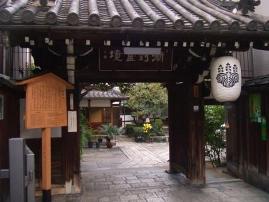
Zuisenji Temple was founded as the graves of Hidetsugu Toyotomi and his family in 1611. So this temple is not for sightseeing. Hidetsugu Toyotomi was a nephew and retainer of Hideyoshi Toyotomi, a Japanese feudal lord who unified Japan in the Momoyama period (late 16th century). Hidetsugu and his family are known for a tragic episode of their life. Hidetsugu was adopted by Hideyoshi, and then he succeeded Hideyoshi’s post and was appointed Kanpaku (a very important person who conducted affairs of state as an assistant to the Emperor). After that, however, Hideyoshi’s own child Hideyori was born in 1593, and Hideyori lost his position as a successor of Hideyoshi. Then the relation between him and Hideyoshi became worse gradually. Hideyoshi came to alienate him because Hideyoshi wanted his own child to take his position. In addition, a rumor about Hideyori’s rebellion against Hideyoshi went around (some say it was a plot to put him in an awkward situation). Finally, in July 1595, for the crime of treason, he was exiled to Mt. Koya (north east Wakayama) and forced to commit suicide by stabbing himself with a sword.

In August 1595, Hideyori’s family (sons, wives, and mistresses) were executed brutally at the riverside of Sanjo-ohashi Bridge. Their corpses were thrown in a hole with Hidetsugu’s head, and a big mound was built on it. It was so-called “Sessyo-zuka”.

After a long time, the mound gradually went to ruin because of floods. Ryoi Suminokura, a wealthy merchant and civil engineer who excavated Takasegawa River, saw it and felt compassion for Hidetsugu and his family. Then it was restored by him and Zuisenji Temple was founded there to bury them.
This temple tells us a tragedy behind the glorious history of Hideyoshi Toyotomi even now.
Kaburenjo of Ponto-cho(先斗町歌舞練場)
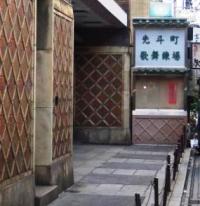
Ponto-cho is a narrow street running between Kiyamachi Street and Kamogawa River. Now this place is widely known as “Ponto-cho,” but at first this area was called “Shin-Kawaramachi.” It’s not clear why people came to call this place “Ponto-cho,” but some say it came from a Portuguese word ponto, or point in English, because houses had gathered around the point (headland) of the west riverside.
Kaburenjo is a theatre built in 1927, Ponto-cho, in Kyoto. In May, Kamogawa Odori, a big event of dancing performance by geisha girls of Ponto-cho, is held here every year. It is one of the most famous, exotic events in Japan.
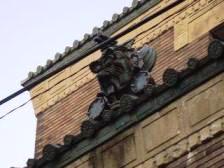
When you look up at the roof of this building, you will see the gargoyle as the symbol of prayer for prosperity. It is in the shape of a mask of Ranryo-ou, a character of Chinese traditional drama.
Tosa-inari / Misaki-jinja (土佐稲荷/岬神社)
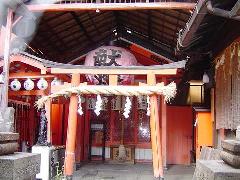
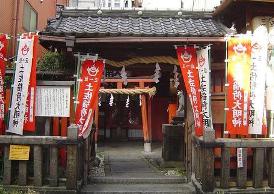
Tosa-inari (Misaki-jinja) is an ancient shrine located in Kiyamachi area. Originally it was founded on the sandbank of Kamogawa River in 1348. People founded it to pray to god for a good crop and for protection of Kiyamachi from floods of Kamogawa River. In the Edo period, the shrine was moved to this place, then Tosa Domain’s estate. The name “Tosa-inari” originates from the name of Tosa Domain. Today, Tosa-inari is visited by many people who pray to gods. They believe the gods save them from fire or evil spirit, and satisfy their wish.
Takasegawa River(高瀬川)
In 1614, Ryoi Suminokura, who was a merchant in Osaka, dug a canal of ten kilometers in length between Nijo and Fushimi. Takase-bune, specially designed boat, was used for transportation on the canal. Since then this canal has been called Takase-gawa River. Before the construction, Kiyamachi Street was not so wide. However, it was widened at the time of construction.
Nine small ports called “Funairi” were built between Nijo Street and Shijo Street to load and unload merchandise. Now, you can see only one Funairi called “Ichino-Funairi.” Lumber, charcoal, firewood, sake, soy sauce, rice, and salt were brought to Kyoto from Osaka. A lot of warehouses were built on Kiyamachi Street to stock them. Special products of Kyoto like wardrobe and tile were also sent to Osaka. More than 170 ships were used to carry the items in its prime. In 1868, Takasegawa River came to be managed by the Kyoto prefectural government and passenger ship service started.
However, Takasegawa River underwent several more changes when the Kyoto city tram began to operate on Kiyamachi Street in Meiji 28 (1895). To build the railway, the width of the river was narrowed and ships stopped their sailing on the river. Finally in 1920, the history of Takase-bune ended.